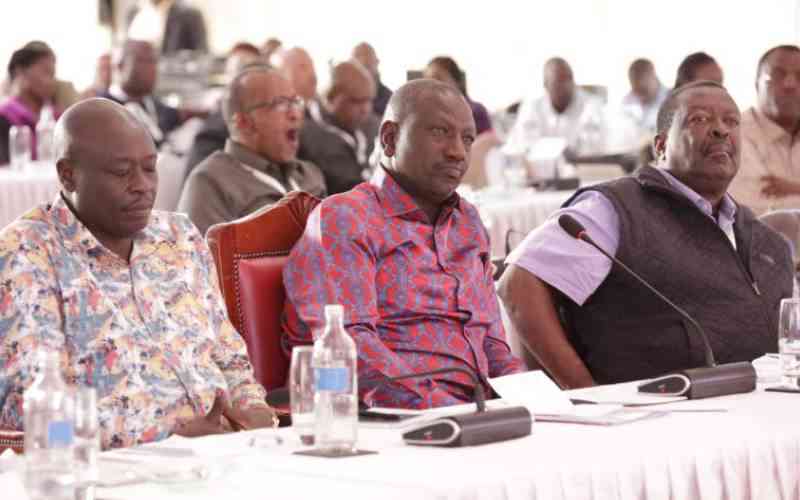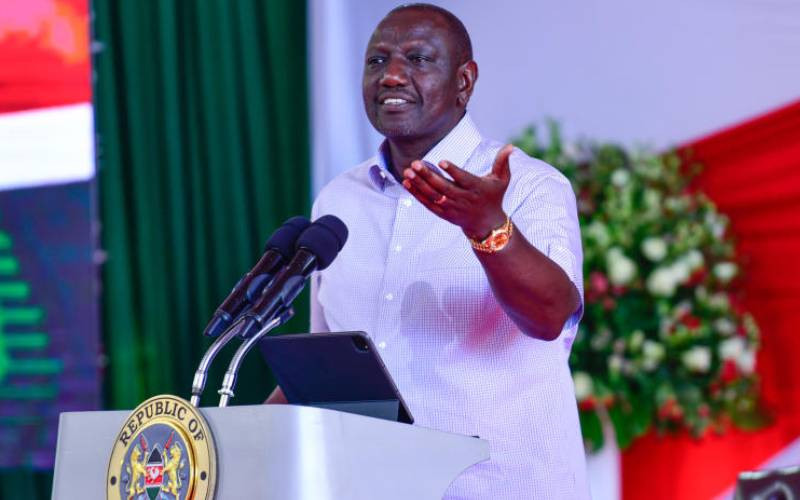
The discussion on President William Ruto's first 100 days is over. His next test should be September 2023, but you can bet we will be here for the six-month report in mid-March 2023.
Why is this administration still full of promises to deliver "within x months" or "by month y"? Is there an emerging national uncertainty about Kenya Kwanza's readiness to prosecute its agenda?
Last week began to offer initial answers. First, the president's mid-week interview was carried on prime-time news across all media. Second was the Cabinet retreat (including other senior officials) at the end of the week. This would have been the political version of synchronised swimming.
Outside of snippets and sound-bites, the interview did not offer the feel of a holistic economic, social, governance or security agenda, or its sub-topics such as education, healthcare, water, agriculture, manufacturing or even linkages with devolution. However, it confirmed the president's state of confidence and determination to get things done and be held accountable.
We don't know much about the dynamics of the retreat, especially behind closed doors and "nyuma ya tent". But its public face seemed positive, with calls to take time to discover Kenya, serve all Kenyans, identify opportunities for private sector participation and digitise ministerial work.
Officials were asked to prioritise decisions and results over bureaucracy and processes. Done well, this delivers better government. Done carelessly, it is a slippery slope to impunity and anarchy.
We also heard that, by retreat end, sectoral and ministerial strategic planning priorities were aligned/updated to capture the Kenya Kwanza manifesto and transformation strategy. Hopefully, this seamlessly fits into the forthcoming fourth Medium-Term Plan of Vision 2030 as well as county-integrated development planning priorities as part of a true "whole of government" lens.
- Community health workers boost counties universal healthcare bid
- Inside UON's digital health facility
- CS Nakhumicha tells Senate 4,129 medical interns posted to hospitals
- Cabinet okays NHIF scrapping if four bills get MPs nod
Keep Reading
But the real test of this problem-solving, solution identification, prioritisation, sequencing and implementation planning and budgeting is the content of the national budget (and county budgets). The best and finest policies and plans have always met "earth is hard" reality at budget stage.
Contextually, how have programmes changed, and what might be the composition of Kenya Kwanza's transformative bottom-up project portfolio in this new programming? More broadly, since the budget is the sum-total of all programmes (not projects), are there signs of new discipline?
Outside of macro-aggregates shared with the IMF before discussion by Parliament, we have little detail on the 2022/23 supplementary budget estimates. But we are in the middle of the 2023/24 budget preparation process. The 2022 Budget Review and Outlook Paper (BROP) was released last December; one purpose being to set 2023/24 resource ceilings for Kenya's 10 MTEF sectors.
Sectors then retreated to develop sector reports (basically 2023/24 resource bids), which are now published. According to Treasury's budget calendar, these reports (and bids) are to be presented to the public in hearings to be held between January 10 and 12; an opportunity for Kenyans to ask hard questions. Assuming this timetable remains valid, let's review the earlier questions above.

As a quick background, useful public participation in the hearings is always served best by studying the reports first. Nine reports are published each year, the exception being the national security sector report (defence and intelligence, not police), which is never discussed in public.
Sadly, these reports are difficult to review, especially for the everyday Kenyan. In the past decade, the average size of a sector report has grown from roughly 100 to 250 pages on account of complex information and analytical requirements specified by the Treasury. The nine reports for 2023/24 sourced from Treasury's website on January 6 totalled 2,789 pages; an average of 300 per report!
Let's go back to the process. Treasury uses BROP to lay out initial resource ceilings to sectors. Sectors present resource bids through their reports and justify them during public hearings.
They incorporate the feedback with updated resource bids into final sector reports submitted to Treasury (by January 19 in the 2023/24 calendar). The same Treasury must issue the draft Budget Policy Statement, which contains final sector ceilings, to Cabinet by January 17, two days earlier. These final ceilings guide preparation of the detailed ministerial budget estimates by end of April.
Given this general picture, you would expect that there wouldn't be a world of difference between Treasury's ceiling and the sum total of sector bids. This was largely the case in the past, but changed in the past decade. By the time we got to the first budget in Jubilee's second term in 2018/19, sector bids exceeded the ceiling by almost Sh700 billion, basically asking for about 40 per cent more than was available. In the next three years (2019/20 to 2021/22), the excess sector request surpassed a trillion shillings each time; or roughly 60 per cent above resources available.
In Jubilee's final budget preparation year (for current 2022/23) the excess fell below the trillion-shilling mark, to about 50 per cent above available funds. Maybe it was the IMF, or maybe not. Because some quick number-crunching for Kenya Kwanza's first full budget for the coming 2023/24 fiscal year reflects a total sector resource bid that is a record Sh1.8 trillion above the ceiling, or almost 80 per cent above the resources available.
Let's repaint this picture for clarity. BROP set out a 2023/24 spending envelope of Sh3.6 trillion, including Sh2.2 trillion in ministerial spending. What the sector picture now says is that the need across all ministries (because sectors are a summation of ministries) is actually Sh4 trillion, and the budget should be Sh5.6 trillion.
We may brush this off as a numbers game until I remind you that sectors will go to public hearings to explain that they need Sh4 trillion to deliver for Kenyans, and they've only been allocated a measly Sh2.2 trillion (implying at the extreme that they can only deliver a fraction of their mandates).

As it has done in the past, Treasury is likely to ignore these bids and stick with its original ceiling, particularly in these IMF times. Which makes this process a public con. I mentioned last time that this is the "budget impunity" that leads to "budgeted corruption", but maybe the reality at the micro-level is that we have "corrupted budgeting", which we don't mind if macro-level balances.
If this is the case, then we don't care about spending outcomes and impacts - which will differ between budget lines, programmes, ministries or sectors - as long as the grand totals are in balance!
Here's the really interesting part. The Cabinet retreat - a "top-down" affair discussing a "bottom-up" agenda - probably concluded with beautifully prioritised, sequenced and costed strategies for every sector and ministry.
Someone is now doing much macro-level thinking to fund this agenda. But it doesn't yet fit into the budget framing that sectors - technical and budget officers below the top honchos - have developed through these reports. That's where the rubber truly meets the road.
The top honchos in the Energy, Infrastructure and ICT sector might be interested in a sector report that seeks a massive Sh1.2 trillion in development spending against a ceiling of less than Sh300 billion.
Education and social protection leaders will probably want to understand the Sh100 billion plus resource gaps in their recurrent spending. Similarly, those in general economic and commercial affairs (trade, tourism, etc) will wonder about a Sh90 billion development spend gap in a sector that enables, not replaces, the private-sector. These excesses cut across all sectors.
Indeed, they lead us into an even more interesting new discovery in the sector reports. None of the sectors actually uses the BROP ceiling because they have their own. For seven out of nine sectors, the ceiling they accorded themselves in their sector reports is higher than Treasury's. We find ourselves in an Oliver Twist space where sectors use their own ceilings and still want more! This is not the planning and budgeting space that can conceivably transform Kenya for Kenyans.
What the sector reports tell me is that this is Kenya Kwanza's first "rubber meets the road" moment!
 The Standard Group Plc is a multi-media organization with investments in media platforms spanning newspaper print
operations, television, radio broadcasting, digital and online services. The Standard Group is recognized as a
leading multi-media house in Kenya with a key influence in matters of national and international interest.
The Standard Group Plc is a multi-media organization with investments in media platforms spanning newspaper print
operations, television, radio broadcasting, digital and online services. The Standard Group is recognized as a
leading multi-media house in Kenya with a key influence in matters of national and international interest.











